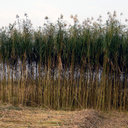Hypoxia inducible factor-1α/B-cell lymphoma 2 signaling impacts radiosensitivity of H1299 non-small cell lung cancer cells in a normoxic environment.
Schlüsselwörter
Abstrakt
Hypoxia inducible factor-1α (HIF-1α) is a critical transcriptional factor for the response of cells to hypoxic microenvironment and its expression induces resistance of hypoxic non-small-cell lung cancer (NSCLC) cells to radiotherapy. This study investigated how the activation of HIF-1α/B-cell lymphoma 2 (BCL-2) signaling under normoxic conditions impacted radiosensitivity of NSCLC cells. The recombinant pcDNA3.0-EGFP plasmids with wild-type or mutant HIF-1α complementary DNA (cDNA) were transfected into H1299 cells, an NSCLC cell line, establishing two H1299 sublines with high expression of HIF-1α. Compared with the levels of HIF-1α and BCL-2 proteins in non-transfected cells, increased levels of both proteins were found in transfected cells. Moreover, the expression of HIF-1α in non-transfected cells induced by chloride cobalt (CoCl2), a commonly used mimetic hypoxia reagent, was concomitant with the enhancement of BCL-2 expression. Conversely, reduction of HIF-1α expression by an inhibitor decreased the levels of BCL-2 proteins. The results revealed that the stabilization and expression of HIF-1α promoted the accumulation of BCL-2 proteins in H1299 cells. Subsequent experiments showed that intracellular HIF-1α/BCL-2 signaling was triggered in a normoxic environment after H1299 cells were exposed to irradiation, causing an elevated radioresistance. In contrast, blockage of HIF-1α/BCL-2 signaling leads to an elevated radiosensitivity. Proliferation of cells assay showed that, under normoxic conditions, population doubling times (PDTs) of irradiated cells were prolonged by suppression of HIF-1α/BCL-2 signaling. It is, therefore, indicated that HIF-1α/BCL-2 signaling activated by ionizing radiation reduces the radiosensitivity of H1299 cells independent of the hypoxic environment.






